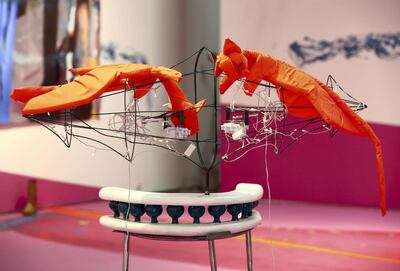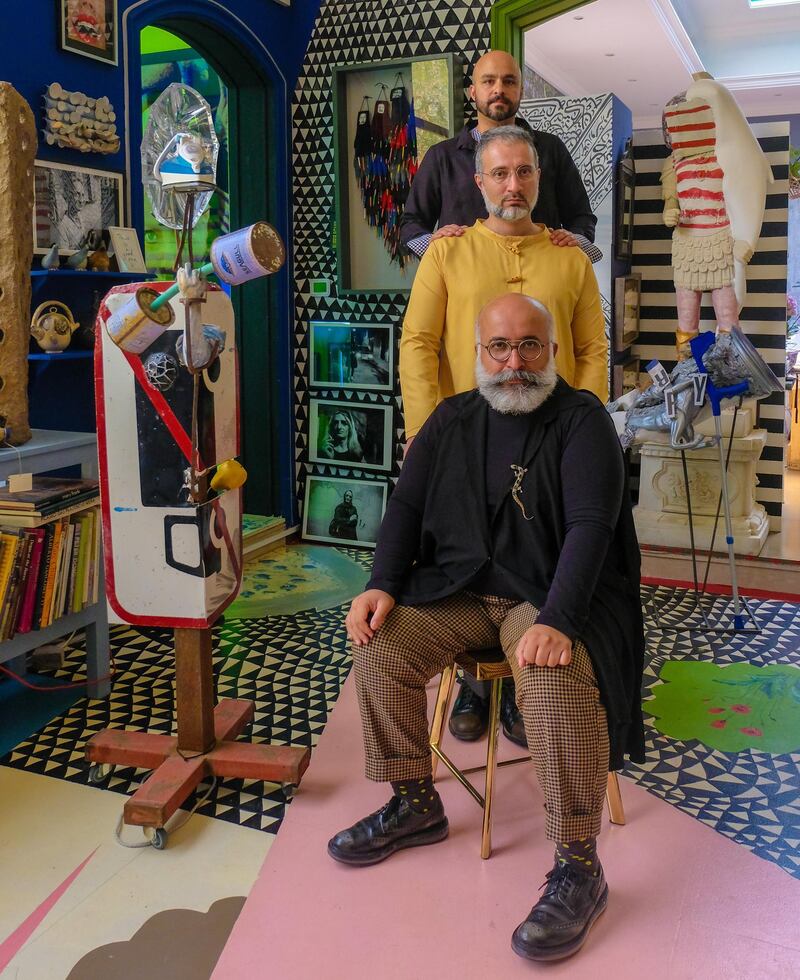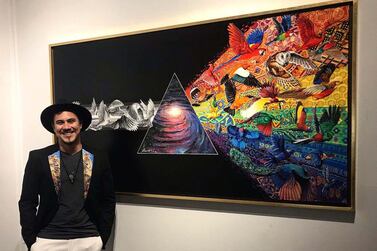The lines between reality and fiction are often blurred in the joint practice of Rokni Haerizadeh, Ramin Haerizadeh and Hesam Rahmanian. Indeed, it is often impossible to tell where the work of one artist begins and the other ends. Together, they occupy the zeitgeist of Generation Z, where myriad influences converge into a bizarre yet salient output. This summer the trio have taken over Gallery Isabelle van den Eynde in Dubai's Alserkal Avenue and are treating it like a working studio. The place has ceased to function as an operational art gallery and, over the course of a few months, the artists are exploring ways to subvert the art world.
“We are thinking about the art world as an organised and, at times, dictatorial system defined by an unspecified source. We are attempting to disrupt that system,” explains Rokni, the younger Haerizadeh brother. “We see this exhibition as being like a think tank, even we are waiting to see what is going to happen.”
This means the artists spend several hours a week in the gallery, working, talking, thinking and experimenting as they would in their home studio. They also punctuate this ongoing work with performances or "activations", which are scheduled for every few weeks.
During the last activation, the artists performed for six hours as what they call "painting machines". With a life jacket wrapped around his head to restrict his vision, and a long dress to restrict his movement, Ramin walked around the space with a large white teapot filled with orange paint. He poured it onto the floor and then walked over it letting a plastic ball that was attached to his leg drag through the paint and leave a trail behind him. Rokni attempted to use only upper-body strength and held himself up on crutches, which left behind marks in yellow paint as he stumbled through the gallery space. Hesam, meanwhile, who also had his sight blocked by a life jacket around his head, was wearing rubber boots and had blue paint all over his hands and shoes, leaving a path of blue along the wall as he traversed along it.
During these performances, similar to those that often appear in their video works, the so-called painting machines perform repetitive acts akin to robots. Using the word dastgah, which is Farsi for "device" or "machine," and in traditional Iranian music refers to the technical term of "melodic matrix", the trio are probing at a deeply conceptual part of their practice: the idea of subject and object.

In a typed statement at the gallery's entrance they write: "By restricting certain physical functions, such as sight or movement, and heightening others like touch and hearing [the machines] move towards a repetitive robotic act as the subjects become objects and vice versa." The written piece goes on to describe their process as continually adapting itself around any disruptions, which is aligned with the way they make art. "We are debuggers of our own practice," says Rokni. Hesam then picks up the thread of the conversation explaining how each piece of their art is the result of this trial and error approach.
“They are negotiation fields,” he says. “We don’t like to categorise artworks using terms like video, painting or collage instead, they are physical results of our conversations and interactions. The results, which are often not finite and can continually change over time, happen through disagreement and negotiations as we pass them to each other and back again.” As if on cue, Ramin finishes the thought: “each piece gives birth to one another,” he says.
When the exhibition opened in May, one of the most striking things about the installation was a cerise pink floor, which will eventually become an artwork in its own right and shipped off to London next year for another show. Within days, the floor was scuffed and marked by the feet of gallery visitors and after the performance it became splattered with paint and demarcated with orange lines. Although it will be painted in more detail and then lacquered, the democratic nature of this work is also indicative of the artists' practice and their open-door policy to all forms of inspiration and collaboration.

However, the marked floor and the random paint splatters are not all that make up the presentation. There are several pieces ("negotiation fields") in both sculptural and wall-based form. One is a scanned, digitally manipulated page from The National, painted upon and annotated and then printed onto a canvas, which was left outside to weather the elements for a number of months.
“The artists are always interested in the fourth dimension in their works,” explains Jonathan Ellis King, the gallery’s manager. “That would be the weather, other people or even current affairs.”
The media and the way news spreads is a leitmotif winding its way through their recent bodies of work. They are intrigued by the migration crisis, where colourful, life jacket-clad refugees become a symbol of exile and dislocation – something the Iranian brothers are familiar with – and they also continually question the framing of these displaced people by mainstream news sources.
In one piece currently on display in the gallery, angular shaped cats modelled from the neon orange-covered foam from the life vests are attached to mini motors allowing them jerky movements. The cats are placed upon a small fabricated balcony. The effect is that of a scene playing out on a theatrical stage where it is not clear if the audience is the spectator or participant. This weaving together of pieces of news reportage in otherwise peculiar and expected situations somehow echoes the modern times in which we live, where we can scroll through completely incongruent images at speed and absorb them into a mixed mesh in our minds. “Our audiences are dastgah as well,” explains Rokni. “When they enter our space, they are also contributors.”
Perhaps this is the best way to think about your own experience when viewing this exhibition-cum-studio space and if you can, try to catch the artists when they are in session, you never know how impactful your visit might be.
We Are Open For Installation runs until September 16 at Gallery Isabelle van den Eynde, Alserkal Avenue, Dubai






